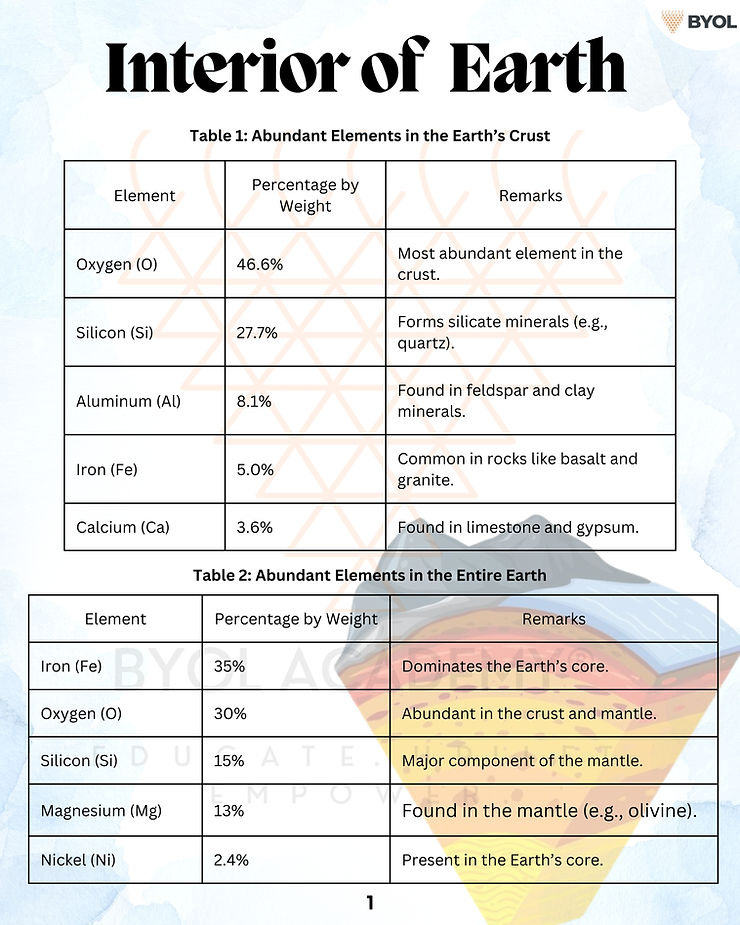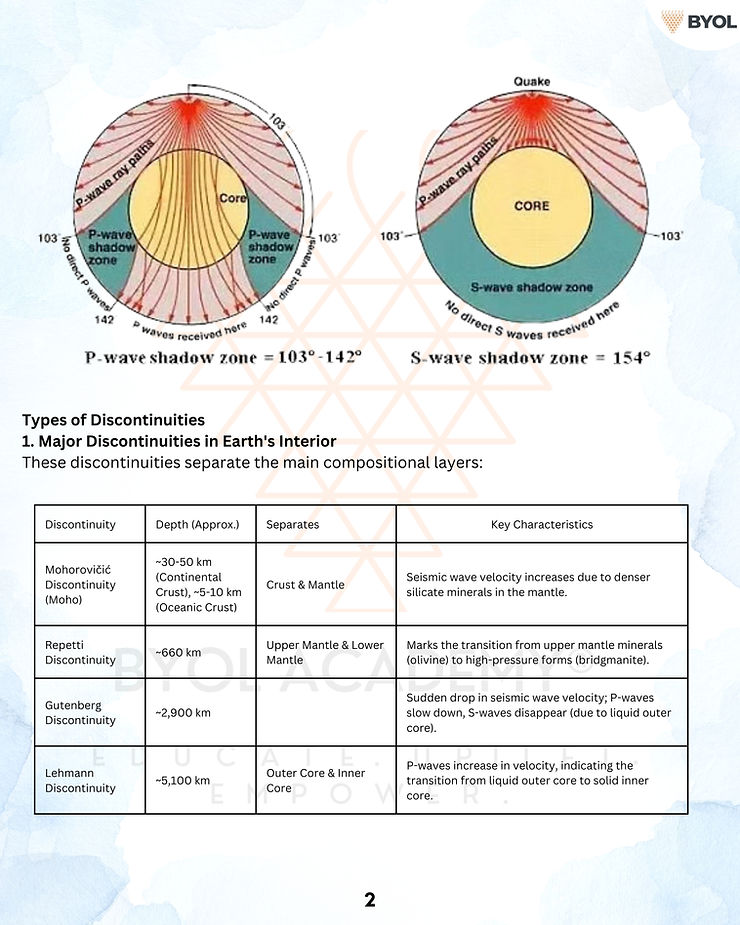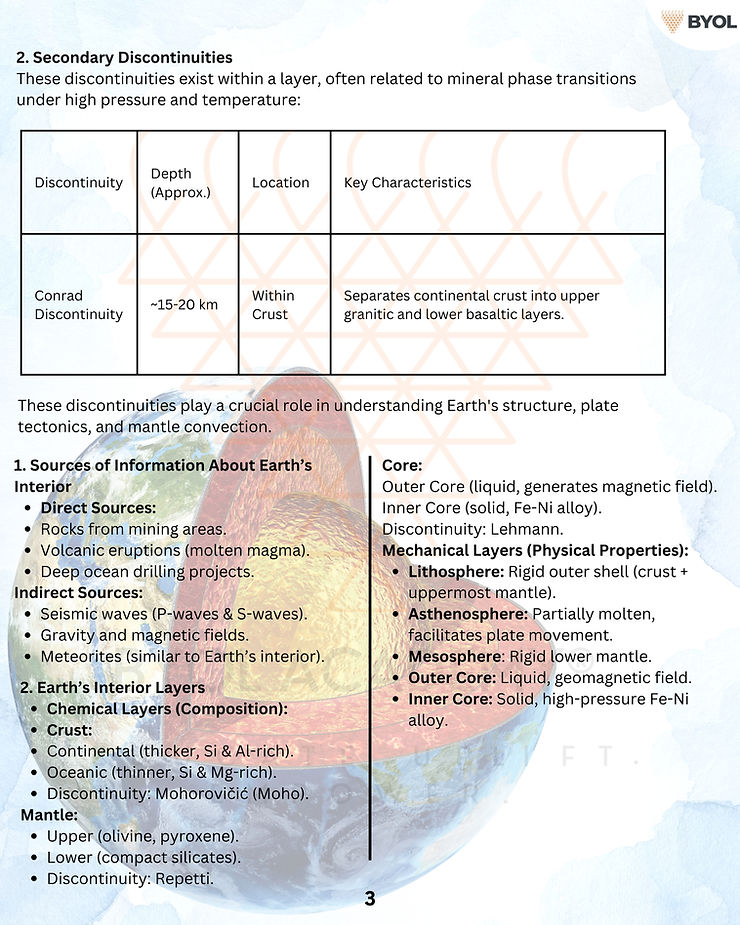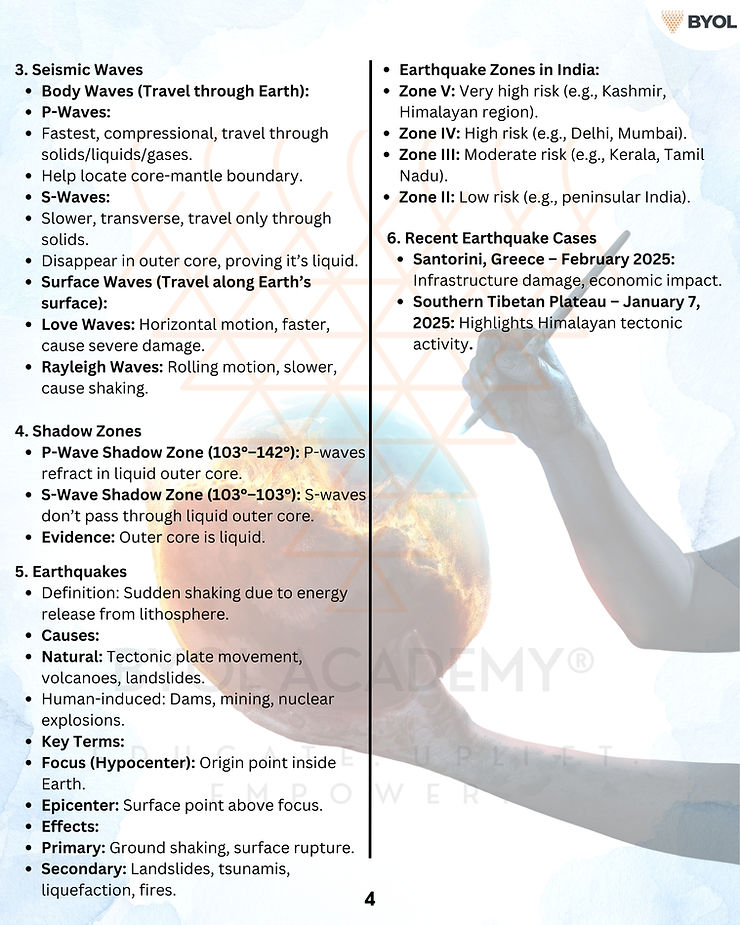Table 1: Abundant Elements in the Earth’s Crust
| Element | Percentage by Weight | Remarks |
| Oxygen (O) | 46.6% | Most abundant element in the crust. |
| Silicon (Si) | 27.7% | Forms silicate minerals (e.g., quartz). |
| Aluminum (Al) | 8.1% | Found in feldspar and clay minerals. |
| Iron (Fe) | 5.0% | Common in rocks like basalt and granite. |
| Calcium (Ca) | 3.6% | Found in limestone and gypsum. |
Table 2: Abundant Elements in the Entire Earth
| Element | Percentage by Weight | Remarks |
| Iron (Fe) | 35% | Dominates the Earth’s core. |
| Oxygen (O) | 30% | Abundant in the crust and mantle. |
| Silicon (Si) | 15% | Major component of the mantle. |
| Magnesium (Mg) | 13% | Found in the mantle (e.g., olivine). |
| Nickel (Ni) | 2.4% | Present in the Earth’s core. |
Sources of Information About the Earth’s Interior
- Direct Sources:
- Rocks from mining areas.
- Volcanic eruptions (provide molten magma).
- Deep ocean drilling projects.
- Indirect Sources:
- Seismic waves: P-waves (primary) and S-waves (secondary) help study the Earth’s interior.
- Gravity and magnetic field: Provide clues about density and composition.
- Meteorites: Represent materials similar to Earth’s interior.
About Interior of Earth
The interior of the earth is made up of several concentric layers of which the crust, the mantle, the outer core and the inner core are significant because of their unique physical and chemical properties.
Mechanically, the earth’s layers can be divided into lithosphere, asthenosphere (upper viscous part of the mantle), mesospheric mantle (part of the mantle below the asthenosphere), outer core, and inner core. Chemically, Earth can be divided into the crust, upper mantle, lower mantle, outer core, and inner core.
1. Chemical Layers (Based on Composition)
(i) Crust
- Outermost layer, composed primarily of silicate rocks.
- Two types:
- Continental Crust (thicker, granitic, Si & Al-rich)
- Oceanic Crust (thinner, basaltic, Si & Mg-rich)
- Discontinuity: Mohorovičić Discontinuity (Moho) – boundary between crust and mantle.
(ii) Mantle
- Composed mainly of silicate minerals rich in Fe, Mg, and SiO₂.
- Upper Mantle: Olivine and pyroxene-rich silicates.
- Lower Mantle: More compact silicate minerals due to high pressure.
- Discontinuity: Repetti Discontinuity (separates upper and lower mantle).
(iii) Core
- Mostly made of iron (Fe) and nickel (Ni) with some lighter elements.
- Outer Core: Liquid, responsible for Earth’s magnetic field.
- Inner Core: Solid due to immense pressure.
- Discontinuity: Lehmann Discontinuity (boundary between outer and inner core).
2. Mechanical Layers (Based on Physical Properties)
(i) Lithosphere
- Rigid outer shell (includes the crust and uppermost mantle).
- Divided into tectonic plates that move over the asthenosphere.
(ii) Asthenosphere
- Partially molten, highly viscous, and ductile layer of the upper mantle.
- Facilitates plate tectonic movement.
(iii) Mesosphere (Lower Mantle)
- More rigid than the asthenosphere due to high pressure, despite high temperatures.
- Composed of high-pressure silicate minerals.
(iv) Outer Core
- Liquid, responsible for Earth’s geomagnetic field (due to convective motion of iron).
(v) Inner Core
- Solid, composed primarily of Fe-Ni alloy, with extremely high pressure preventing melting.
Discontinuity in Earth’s Interior
A discontinuity in Earth’s interior refers to a boundary where there is a sudden change in the physical or chemical properties of Earth’s layers, such as density, composition, seismic wave velocity, or phase state. These discontinuities are identified by studying seismic waves, as their speed and behavior change when they pass through different layers.
Seismic Waves
Seismic waves (earthquake waves) are the most important source available to understand the layered structure of the earth.
The velocity of seismic waves changes as they travel through materials with different elasticities and densities.
The more elastic and denser the material is, the higher the velocity. They also undergo reflection or refraction when they come across materials with different densities
The seismic waves or earthquake waves are basically of two types — body waves and surface waves.
Body Waves (Travel through Earth’s Interior)
These waves move inside the Earth and provide crucial information about its internal layers.
| Type | Full Form | Nature of Motion | Speed | Medium of Travel | Effect on Earth’s Structure |
| P-Waves (Primary Waves) | Longitudinal or Compressional Waves | Push-Pull (like sound waves) | Fastest (first to reach) | Travel through solids, liquids, and gases | Help locate Earth’s core-mantle boundary |
| S-Waves (Secondary Waves) | Transverse or Shear Waves | Side-to-side (like water waves) | Slower than P-Waves | Travel only through solids (not liquids) | Used to determine liquid nature of outer core |
P-Waves pass through all layers, but S-Waves disappear in the outer core, proving it is liquid.
The velocity of waves changes at different layers, helping identify discontinuities (e.g., Moho, Gutenberg, Lehmann).
Surface Waves (Travel Along Earth’s Surface)
These waves cause most of the destruction during an earthquake. They travel slower than body waves but are more damaging.
| Type | Nature of Motion | Speed | Effect |
| Love Waves | Move horizontally, side-to-side | Faster than Rayleigh Waves | Cause severe damage to buildings |
| Rayleigh Waves | Rolling motion (like ocean waves) | Slowest | Cause both vertical and horizontal shaking |
These waves are used for earthquake intensity studies.
Most damage to infrastructure is due to Surface Waves.
Shadow zones
The shadow zone is a region on Earth’s surface where seismic waves from an earthquake are not detected due to their behavior in different layers.
P-Wave Shadow Zone (103°–142°): P-waves bend (refract) when passing through the liquid outer core, creating a gap in detection.
S-Wave Shadow Zone (103°–103°): S-waves do not pass through the liquid outer core, creating a larger shadow zone.
Shadow zones provide strong evidence that Earth’s outer core is liquid and help study Earth’s internal structure.
What is an Earthquake?
- Definition: Sudden shaking or trembling of the Earth’s surface caused by the release of energy from the Earth’s lithosphere.
- Causes:
- Natural: Movement of tectonic plates, volcanic eruptions, or landslides.
- Human-induced: Reservoir-induced seismicity (e.g., dams), mining, or nuclear explosions.
Key Terms:
- Focus (Hypocenter): The point inside the Earth where the earthquake originates.
- Epicenter: The point on the Earth’s surface directly above the focus.
Effects of Earthquakes:
- Primary Effects:
- Ground shaking, surface rupture.
- Secondary Effects:
- Landslides, tsunamis, liquefaction, and fires.
Earthquake Zones in India:
- Zone V: Very high risk (e.g., Kashmir, Himalayan region, Gujarat).
- Zone IV: High risk (e.g., Delhi, Mumbai).
- Zone III: Moderate risk (e.g., parts of Kerala, Tamil Nadu).
- Zone II: Low risk (e.g., peninsular India).
Recent earthquake cases
1. Santorini, Greece – February 2025
Significance: Santorini, a major tourist destination, faced infrastructure challenges and economic impacts due to the evacuations and damage.
2. Southern Tibetan Plateau – January 7, 2025
The earthquake’s location in a seismically active region underscores the ongoing tectonic activity along the Himalayan belt.






